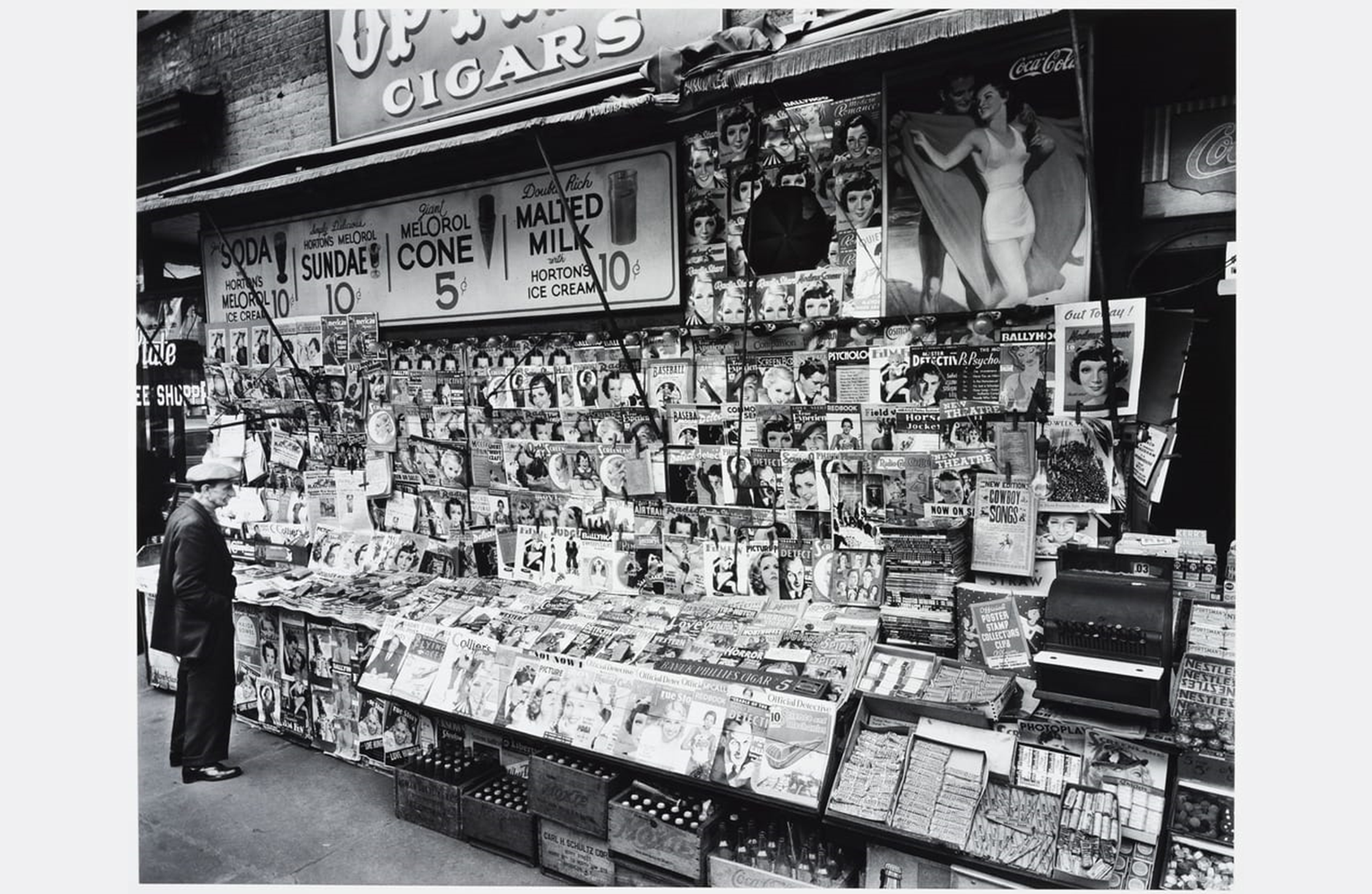As publishing in American society moved from the 1800s to the 1900s, there was a change in how popular fiction was supplied to the American people. Hardback books and the mainstream magazines like Cosmopolitan, Century, Popular Magazine, Strand Magazine, and Atlantic have always been around since publishing became prevalent, and included plenty of fiction. But much of popular fiction was not distributed by the mainstream magazines. During the last half of the 19th century, Dime Novels (or in Britain, called the Penny Dreadfuls) — which I talked about in my column last month — and paper wrapped books were the inexpensive, mass-market purveyors of popular fiction. These were followed by the Pulps (a.k.a. Pulp Magazines) in the first half of the 20th century. The pulps eventually evolved into paperback books (i.e. Pocket Books 1939 and Penguin Books 1935 in Britain) and Digest magazines (6.5x8”), which took over the popular fiction distribution in the later part of the 20th century.
Most people today are unfamiliar with pulps, although they were the early promoters of American popular fiction. Pulps came in two basic sizes: normal pulps (7”x10”) and bedsheet pulps (8”x11”, which were more uncommon). The name ‘pulps’ comes from the low quality pulp paper used for the pages, although they typically had a brightly-colored, slick wrapper. The cost for a pulp magazine was usually about $0.25. If you someone went to a newsstand in the first half of the 1900s, they would find it would be full of all types of pulps.
Bedsheet pulps
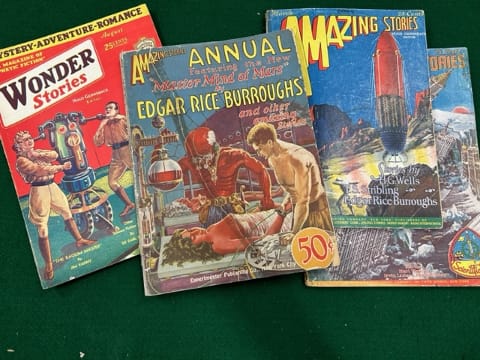
Pulps offered most of the genres of popular fiction, including: science fiction/fantasy, supernatural/fantasy, mystery, adventure, westerns, aviation, sports, love stories, historical, railroad, and spicy stories. Authors like Edgar Rice Burroughs (Blue Book, All-Stories, and Argosy), Robert E. Howard (Weird Tales), H. P. Lovecraft (Weird Tales), Dashell Hammett (Black Mask), Earle Staley Gardner (Black Mask), and Leslie Charteris (Detective Class, Thriller, and British) all got their starts in the pulps. In fact, pulps were the birthplace of popular science fiction/fantasy/horror stories. Mary Shelley was the mother of science fiction/fantasy/horror in the early 1800s, but popular stories in this genre really began spreading with the publication of Weird Tales and Amazing Stories pulps in the 1920s.
In 1923, Weird Tales became the primary publisher of weird and supernatural stories, and included cover art by the first woman illustrator of science fiction, Margaret Brundige. Some other popular pulps included: Horror Stories, Terror Tales, Dime Mystery Magazine, Thrilling Mystery, Eerie, Sinister, Unknown, Uncanny Tales, and Marvel Tales.
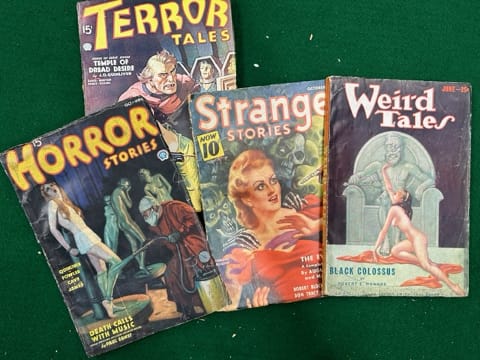
Standard size pulps
The first science fiction/fantasy pulp was the short-lived Thrill Book, which was published in 1919 and only existed for 16 issues. Hugo Gernsback’s company The Experimenter began publishing the first major science fiction magazine, Amazing Stories, in 1926; in addition, Gernsback was an early promoter of radio and television. He was involved in the coining of the term Science Fiction, although his initial proposal was Scientification. The 1927 Amazing Stories Annual had the classic science fiction cover art of Frank R. Paul for Edgar Rice Burroughs’ Master Minds of Mars. In 1929, Gernsback lost control of the publishing company for Amazing Stories, then went on to publish Pulps in Thrilling Wonder Stories and its associated magazines. Amazing Stores was still being published into the 21st Century, and now it is occasionally available as an online magazine.
Another major science fiction pulp was Astounding Stories, beginning in 1930 and eventually evolving into the digest magazine Analog. Astounding’s publishers and editors included William Clayton and John W. Campbell. Astounding Stories is where many of the major modern science fiction writers started out, such as Isaac Asimov, Robert Heinlein, Frank Herbert, Frederich Pohl, and Joe Haldeman. Astounding Stories/Analog is considered one of the best quality science fiction magazines.
Some of the other early science fiction pulps included: Planet Stories, Startling Stories, Famous Fantastic Mysteries, Thrilling Wonder Stories, Dynamic Science Stores, Captain Future, Big Story Magazine, Future Fiction, Doc Savage, Super Science Stories, Fantastic Adventures, Dr. Death, Fantastic Stories, Fantasy, Tales of Wonder, Science Fiction Quarterly, Starling Stories, Fantastic Novel, and Out of this World.
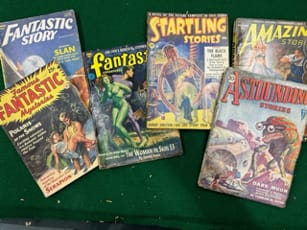
The pulp mystery stories included: The Shadow, Black Mask, The Spider, Detective Story Magazine, Dime Detective Magazine, Ghost Super Detective, Real Detective Tales, Spy Stories, Mystery Stories, Detective Tales, Ace G-man Stories, Gangster Stories, Double Detective, Nick Carter Magazine, Operator 5, Mammoth Mystery, and Dime Mystery Magazine.
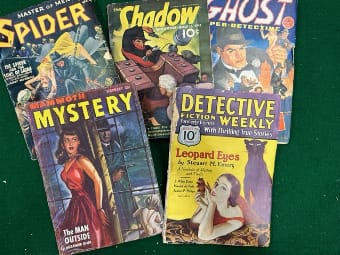
The adventure pulps included: Adventure, Argosy, All Story, Cavalier, Complete Stories, Jungle Stories, Blue Book, Wide World Adventures, Short Stories, Adventure Stories, Daring, Adventure, Top Notch Magazine, Far East Adventure Stories, Oriental Stories, and Man Stories.
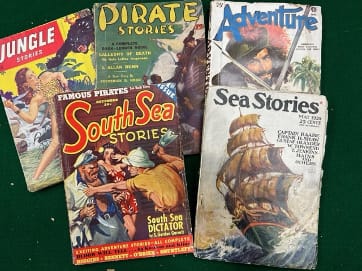
Western pulps included: Ranch Romances, Western Magazine, Dime Western Magazine, Complete Western Book Magazine, Star Western, Ace-High Novels, Complete Northwest Novel, 44 Western Magazine, and Frontier Stories.
Aviation and war pulps included: Dusty Ayres and his Battle Birds, Terence X. Oleary and his War Birds, G8 and His Battle Aces, Foreign Legion Adventure, War Stories, Navy Stories, Air Adventures, Soldier Stories, Flying Aces, Zeppelin Stories, and War Novels.
Sports pulps included: Best Sports, Dime Sport Magazine, Ace Sports Monthly, Fight Stories, Sport Story Magazine, Knockout Magazine, 12 Sports Aces, and Football Action Thrilling Sport.
Romance pulps included: Ranch Romances, Love Story Magazine, Cupid’s Diary, Love Romances, All-Story Love Tales, Charm Story, Western Romances, Hollywood Love Romances, Thrilling Love, and Glamorous Love Stories.
Historical pulps included: Golden Fleece, Argosy, Cavalier, All-Story Magazine, Wide World Adventures, Sea Stories, Magic Carpet, Piracy, South Sea Stories, Big Story Magazine, Blue Book Magazine, and Oriental Stories.
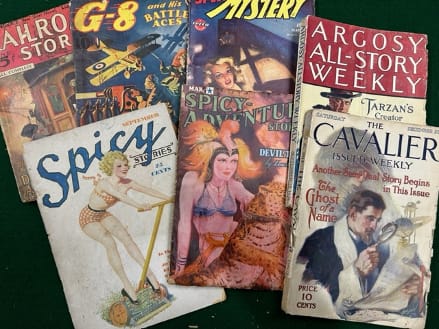
One of the railroad store’s pulps was Railroad Stories.
Spicy story pulps included: Snappy, Spicy Mystery, Speed Adventure Stories, Spicy Adventure Stories, Mystery Adventure Magazine, Yellow Book, Breezy, Spicy Western, Spicy Detective, Saucy Stories, Stage and Screen, New York Nights, Snappy Detective Stories, Bedtime Stories, Detective Stories, Tattle Tale, Pep Stories, and Parisian Life.
By the middle 1950s, the pulp craze had died out, but they remain an archive of much of our early popular fiction. With the exception of a few reprint books, they are only available at a collectible or antiquarian bookstore and are becoming quite scarce.
Reference:
- Ellis, Douglas et al; The Art of the Pulps An Illustrated History, Elephant Book Co. LTD, 2017.
- Goodstone, Tony; The Pulps, Chelsea House Pub.1970.
- Robinson, Frank M., Lawrence Davidson; Pulp Culture the Art of Fiction Magazines, Collector Press, 2001.
- Hersey, Harold Brainerd; Pulpwood Editor, Frederick A Stoke Co., 1937.
- Haining, Peter; The Fantastic Pulps, Vintage Books, 1975.
- Gruber, Frank; The Pulp Jungle, Sherbourne Press, 1967.
Steven Woolfolk is the owner of Xenophile Bibliopole & Armorer, Chronopolis Xenophilebooks.com
